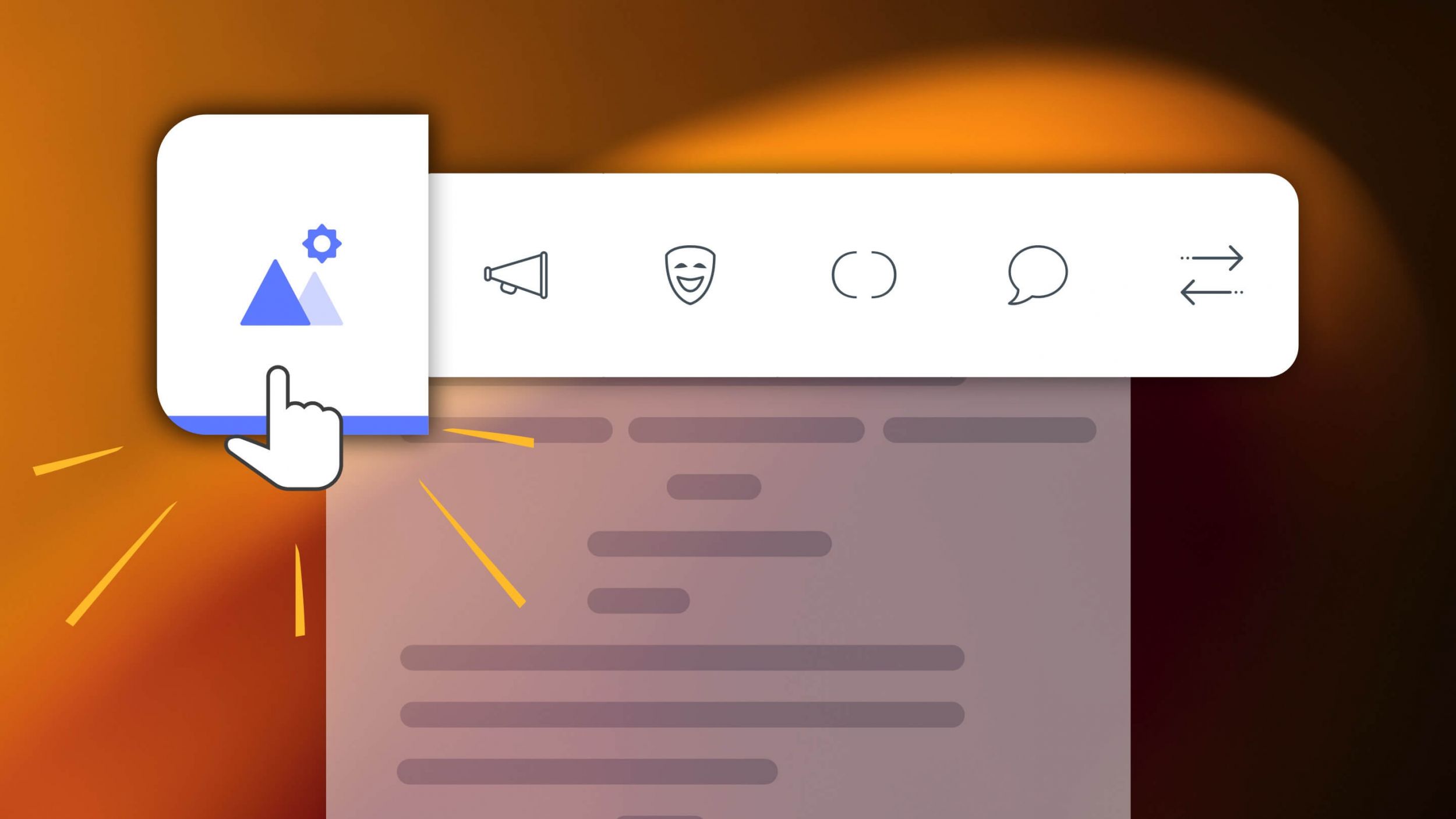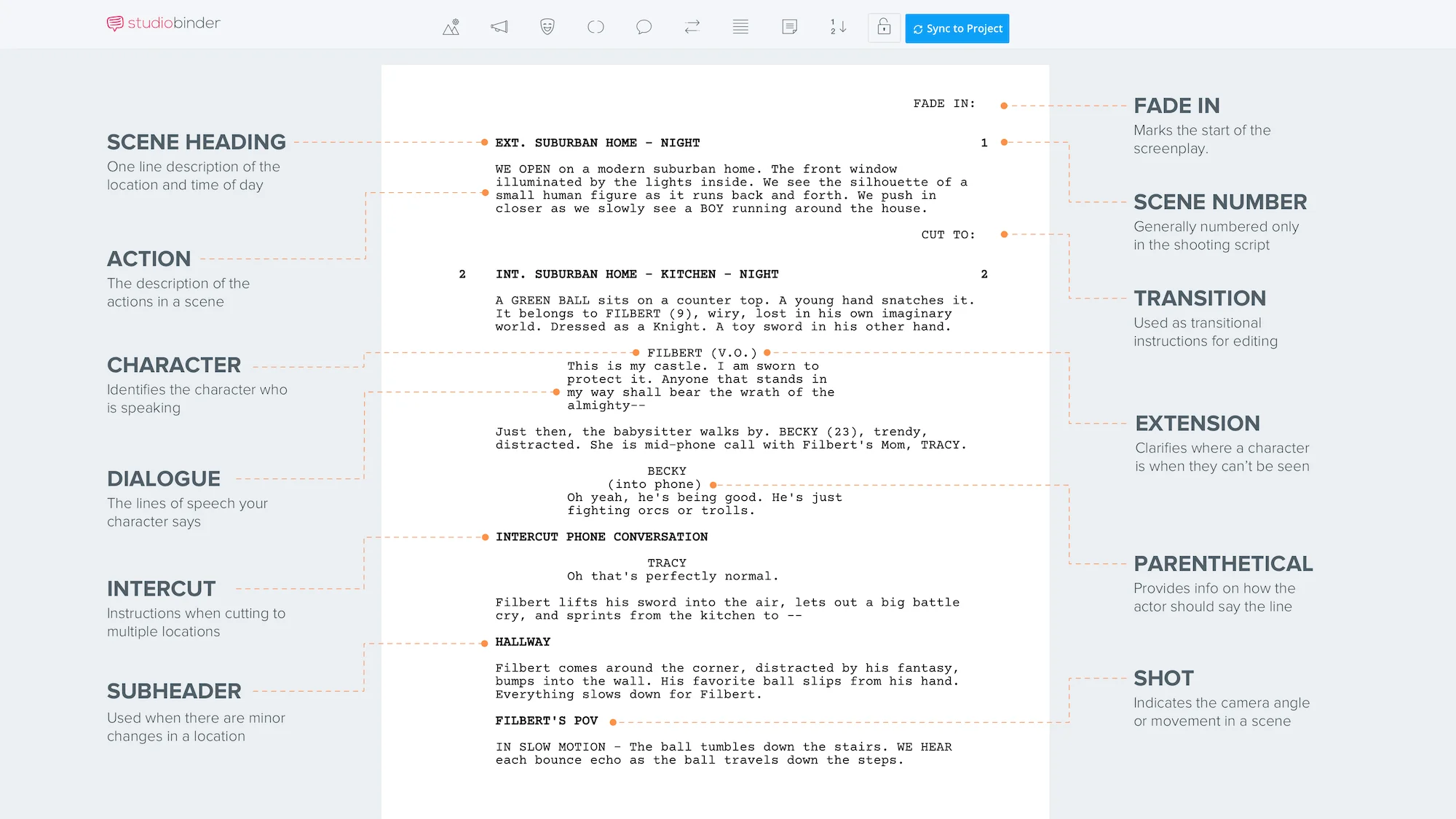Understanding how to write a movie script, also known as a screenplay, can seem daunting at first, but once you understand script format and structure, you can focus on your creativity. We’ll take you through the process of writing a screenplay so that you can begin building that great movie idea into a professional script. If you’re wondering how to write a script, this guide will give you the steps.
Watch: Anatomy of a Screenplay — Ultimate Guide
What Is a Screenplay?
Understanding movie script writing
A screenplay is the industry standard document that serves as the foundation for a film. Understanding how to write a film script involves mastering structure, format, and storytelling techniques. Proper film script format helps ensure that a screenplay is easy to read and execute during production. For those learning how to write a script, knowing proper screenplay structure is crucial. A movie script length typically ranges from 70 to 120 pages, with most feature films averaging around 110 pages. This length is crucial because one page of script format equals roughly one minute of screen time. A strong grasp of movie script format helps ensure your screenplay is production-ready.
Understanding how to write a screenplay goes beyond just length—it’s about mastering the structure, formatting, and visual storytelling that makes a script effective. In this guide, we’ll break down scriptwriting step by step, ensuring you grasp the movie script format and essential screenplay elements like scene headings plot points, and how to format dialogue and action lines correctly.
How To Format a Screenplay
Movie script formatting guide
To format a screenplay correctly, follow industry standards that ensure clarity and readability. Every scriptwriter must understand formatting rules to ensure their screenplay is industry-ready. A well-structured film script format ensures clarity and ease of production. If you’re learning how to write a film script, mastering formatting is key to making your screenplay look professional. This structure is essential for scriptwriters aiming for a professional film script format. Here’s how to properly format your movie script:
- Font: Always use Courier font (12-point)—it ensures a consistent page-to-screen ratio where one page equals roughly one minute of screen time.
- Margins:
- Left: 1.5 inches (for hole-punching and binding)
- Right, Top & Bottom: 1 inch
- Line Spacing: Each page contains about 55 lines, balancing readability and efficiency.
- Dialogue Formatting: Character names should always be in uppercase, positioned 3.7 inches from the left margin.
- Character Names: Must have uppercase letters and be positioned starting 3.7 inches from the left side of the page
- Page Numbers: Placed in the top-right corner, beginning on page two.
StudioBinder screenwriting software does all the required formatting so you can focus on the creative. Below is a formatted script example that you can click to examine further:
Script formatting breakdown in StudioBinder
Many scripts begin with a transition, which may include FADE IN: or BLACK SCREEN. Professional screenplay writing software ensures your script adheres to industry standards automatically. Some place this in the top left, others in the top right of the page where many transitions live. Other scripts will begin with scene headings or even subheadings of imagery they want to front load.
Scene heading (INT. APARTMENT – NIGHT)
The scene heading is there to help break up physical spaces and give the reader and production team an idea of the story’s geography.
You will either choose INT. for interior spaces or EXT. for exterior spaces. Then, a description of the setting, and then the time of day.
Here’s a screenplay example:
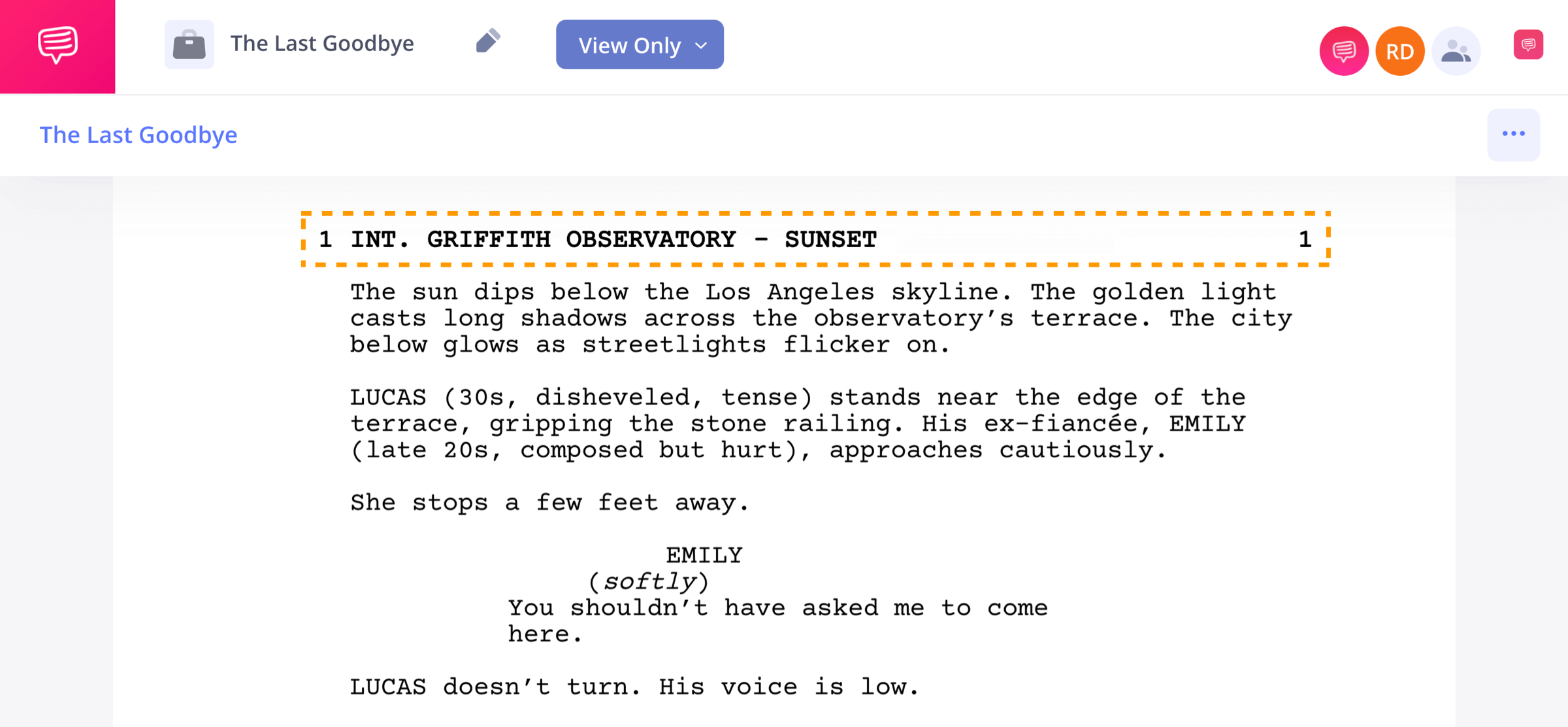
Script format example: Scene Heading
There are rare cases where the scene begins inside and goes outside, or vice versa, and in these situations, you may write INT/EXT. or EXT/INT.
Some scripts take place all around the world, so often screenwriters will use multiple hyphens to give the scene headings even more detail:
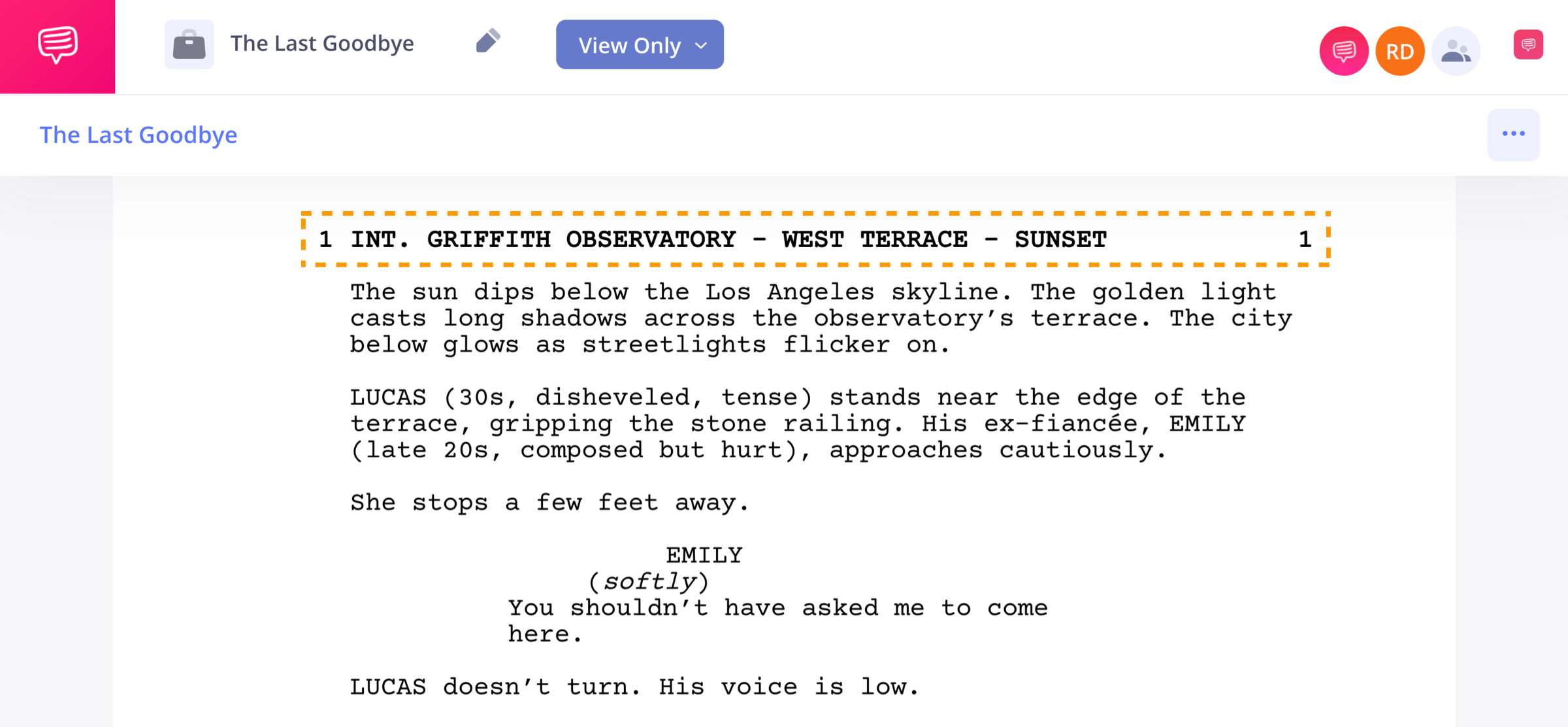
Screenplay format example in StudioBinder Screenwriting App: Scene Heading Details
This helps the screenwriter avoid having to point out the geographical location in the action lines, saving space to write more about the actual story and keep readers engaged in the story, not the formatting.
Subheading
Often, writers will use subheadings to show a change in location without breaking the scene, even if the scene has shifted from INT. to EXT.
Here’s a script example:
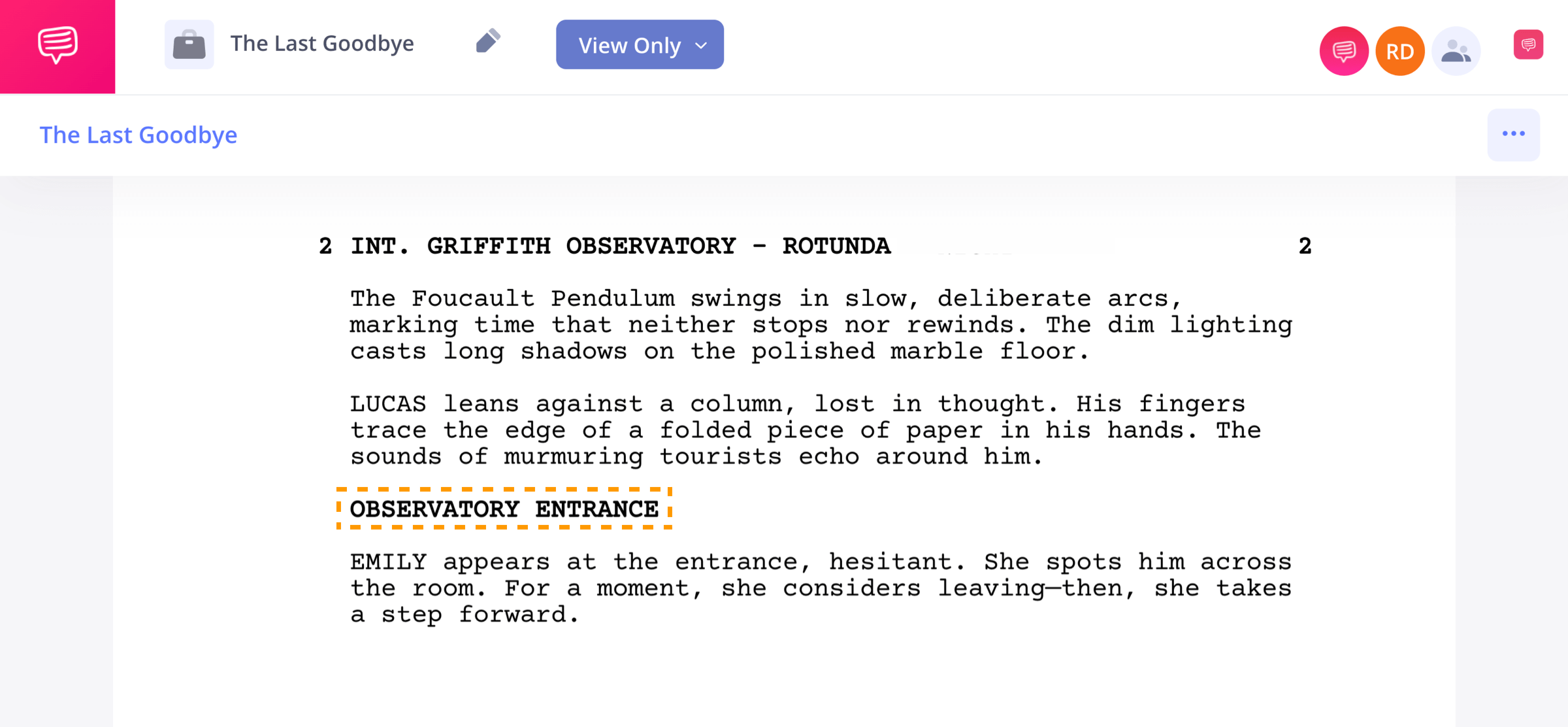
Script formatting example: Scene Subheading
It is assumed that readers will understand the change in space while retaining the idea that the time of day is the same - even continuous.
The reason many writers do this is to avoid the notion that we’ve entered an entirely new scene, though you could always include CONTINUOUS in place of DAY or NIGHT by creating an entirely new scene heading.
It’s a matter of personal style and rhythm vs. production considerations.
Transitions (FADE IN, CUT TO)
In the bottom right of the page, you will place transitions, but in modern screenwriting, these seem to be used less and less. The transitions that seem to have stood the test of time are CUT TO and FADE OUT.
Here’s a screenplay example:
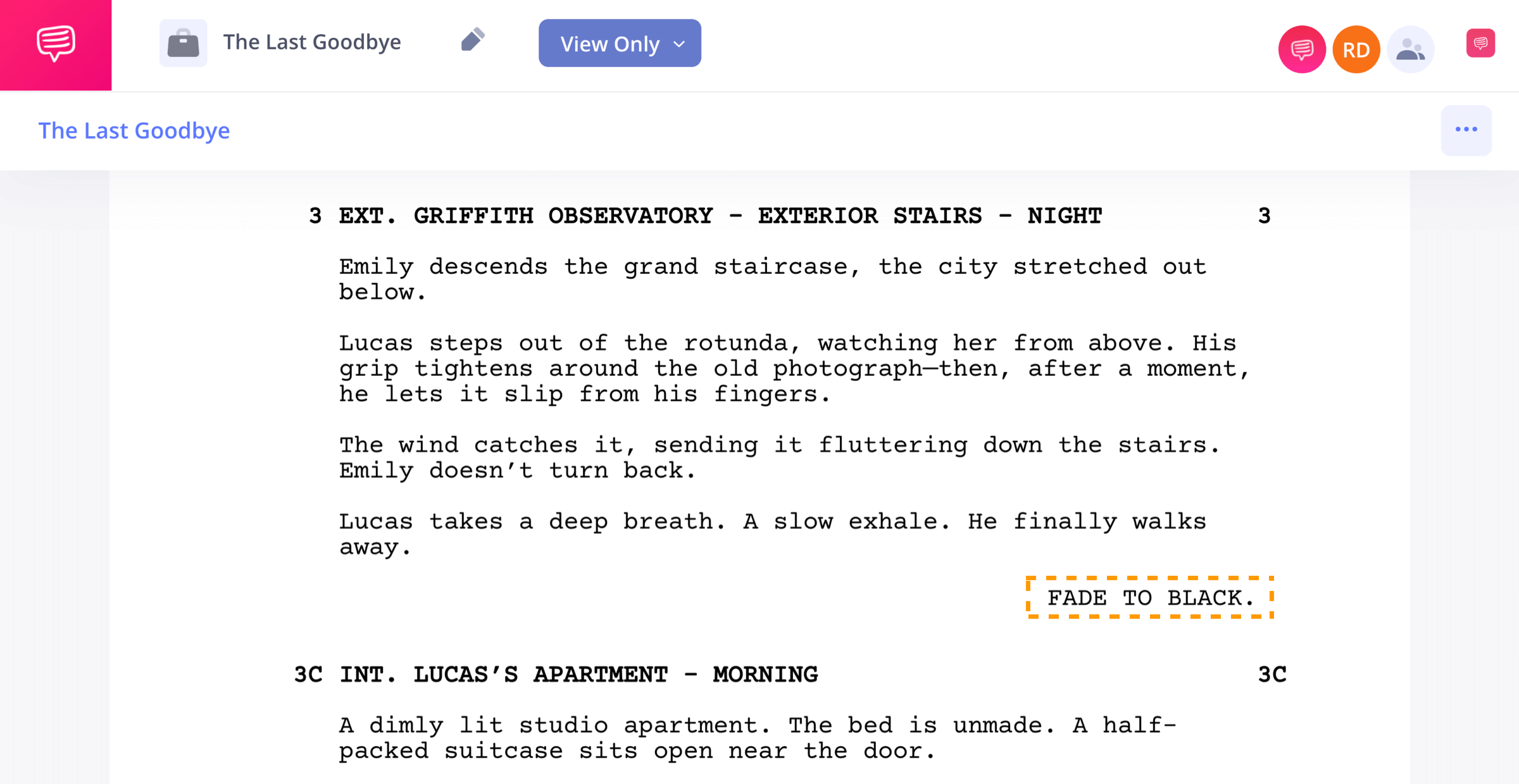
Screenplay formatting example: Scene Transition
You may also include something like DISSOLVE TO: but these are used less and less, probably for the same reason you avoid camera shots.
Character Introductions
When you introduce a character in a screenplay, you want to use all capital letters for the name of the character, then a reference to their age, and finally some information about their traits and personality.
Here’s a screenplay example:
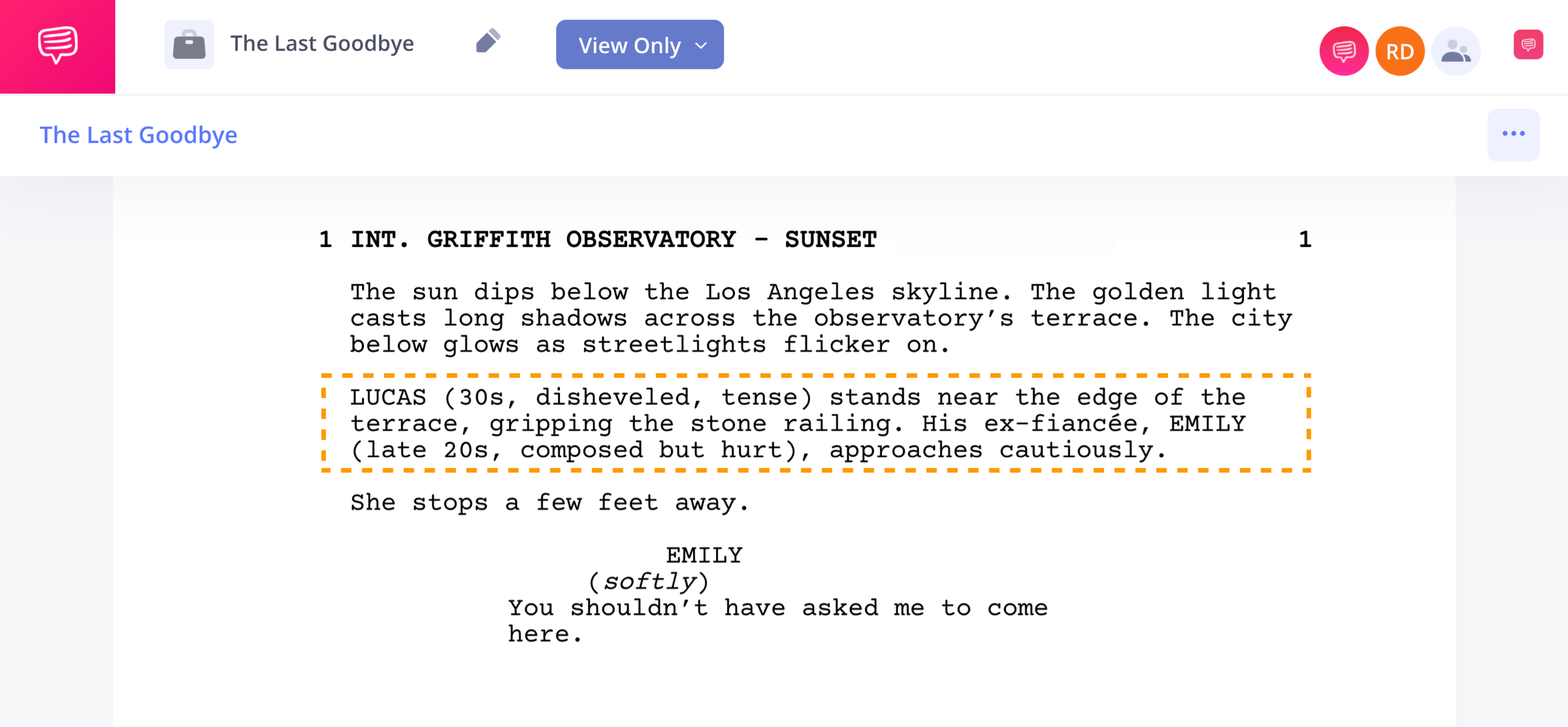
Script format example: Character Introduction
Again, screenwriters have found other ways to do this, but this is the most common and production-friendly way to introduce a character.
We have a post on how to introduce characters in a screenplay that goes into the creative considerations of introducing characters, so I highly recommend you check it out after this post to learn more.
Action (what’s happening visually)
Action lines are where you describe the visual and audible actions that take place on screen. You want to write in the third person in the present tense.
Here’s a script example:
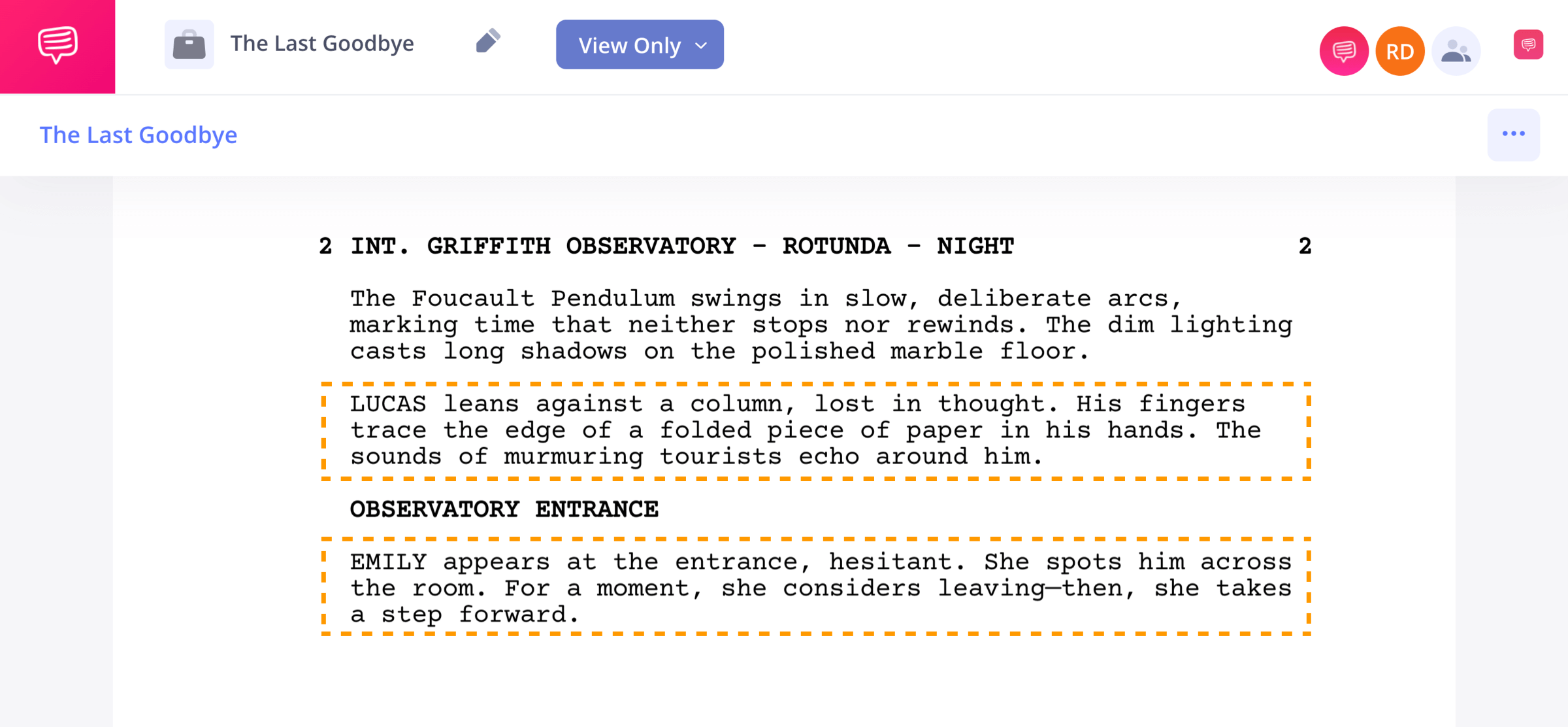
Script format example: Action Lines
Often, you can make your script a better read by eliminating redundant pronouns and conjunctions. Big sounds and important objects can be written out in ALL CAPS to emphasize their effect on the story.
Dialogue
Your lines of dialogue will be set underneath the character to which they are assigned. Dialogue is pretty straightforward from a formatting standpoint, but it is the most difficult part of screenwriting.
Here’s a great example to check out:
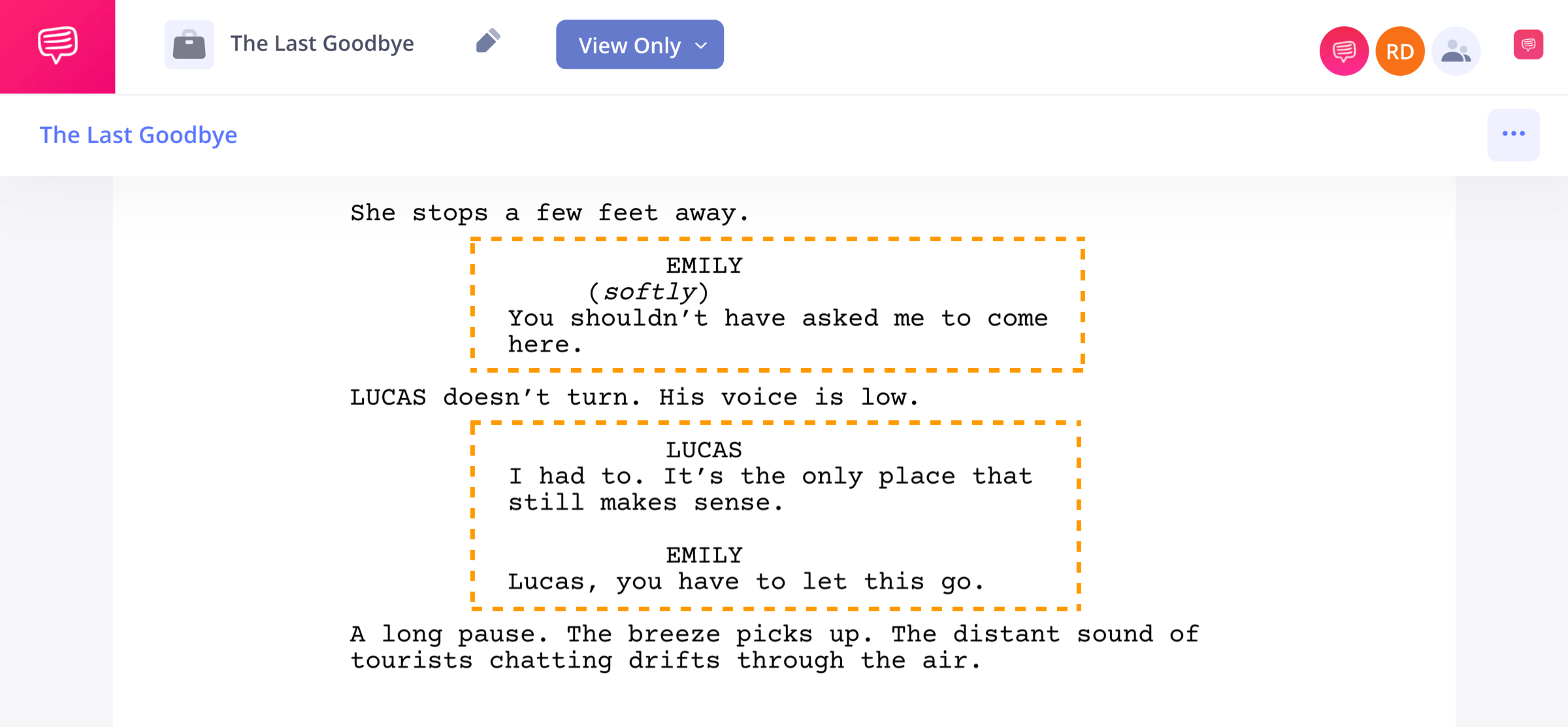
Script format example: Dialogue Lines
If you want to learn more, check out our post on Screenwriting Tips for Writing Better Dialogue, where I go over a bunch of ways to audit your screenplay for good… and bad dialogue.
Extensions
These occur when a character says something off-screen (O.S.) or if the dialogue is voice-over (V.O.). You will see extensions when a character ends a block of dialogue, performs an action, and speaks more.
Here’s a script example:
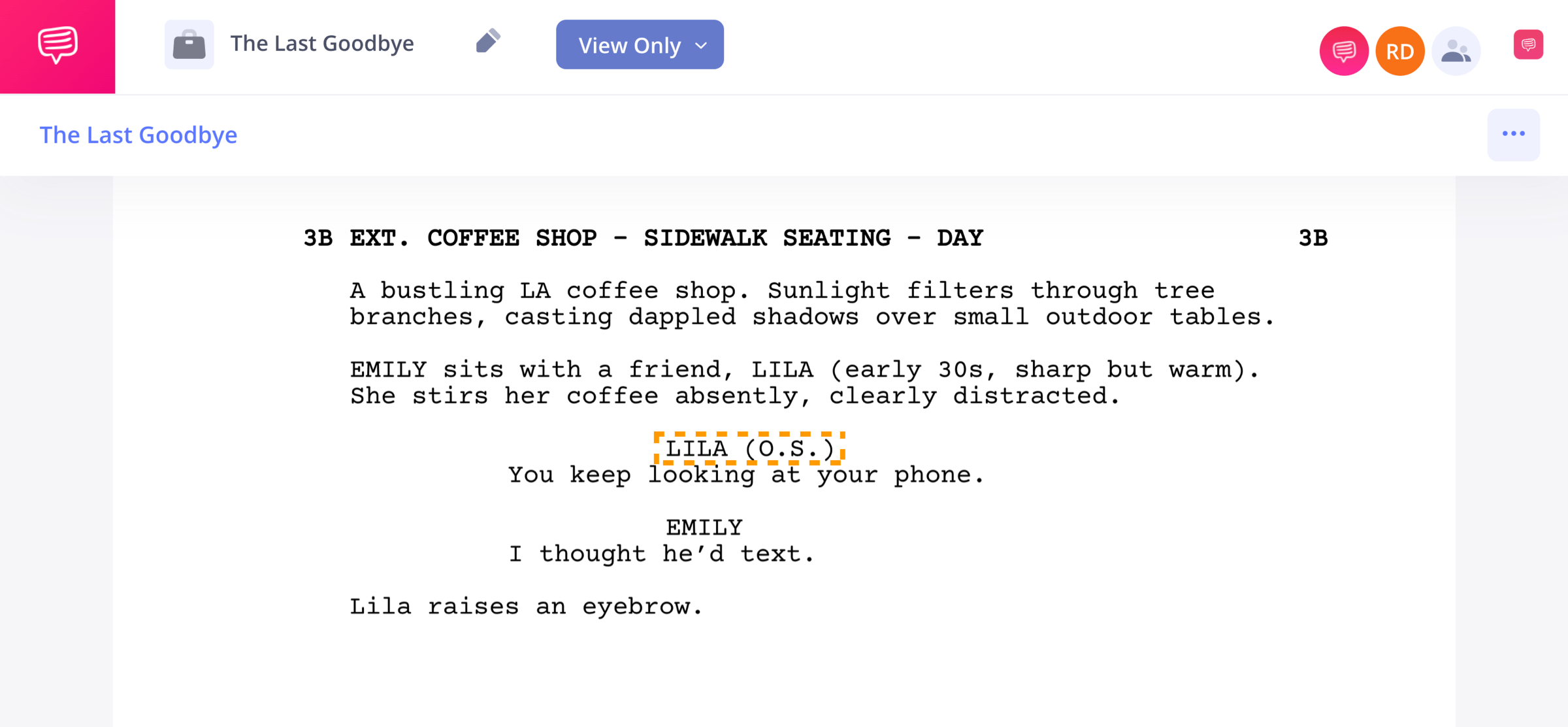
Screenplay format example: Extensions
This takes the form of continued (CONT’D). Professional scriptwriting software will help you with this, but it will not be able to predict when you want something said off-screen or in voice-over.
Parenthetical
You can use a parenthetical inside your dialogue to show small actions or even a change in mood without having to jump out to an action line.
Here’s a screenplay example:
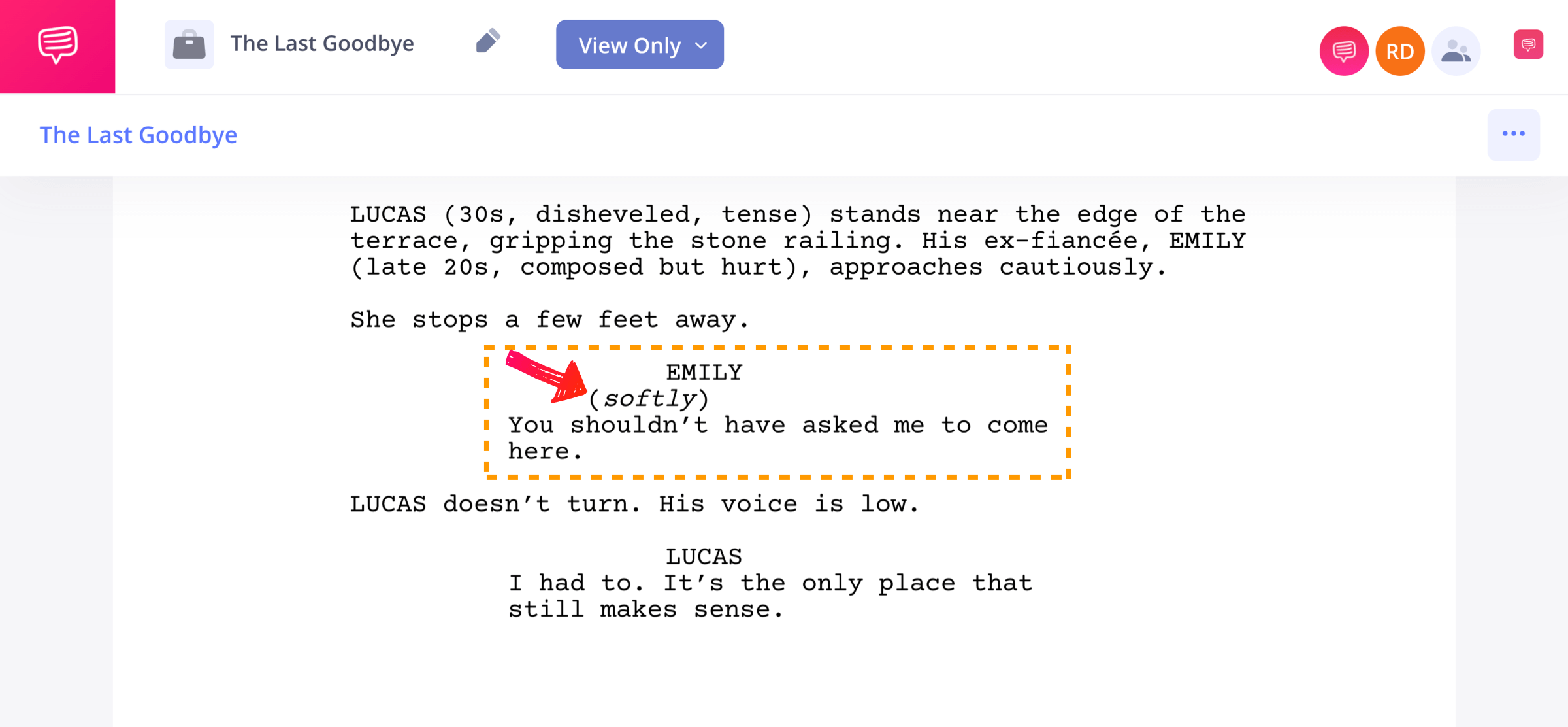
Script format example: Parenthetical
Parentheticals are good for directing actors and adding sarcasm and nuance to performances on the page, but you may want to be cautious about adding them too much. Actors are professionals, and if Al Pacino finds parentheticals in a script, he may get his feelings hurt.
Camera Shots
The best professional screenwriters know how to suggest shots without actually writing in shots, but if you insist on describing a particular shot in your screenplay, you can format it like a subheading.
Here’s a script example

Script format example: Camera Shot
This lets us know that the shot is supposed to be set so that we see things from Filbert’s perspective. Writing out shots is often frowned upon, but if you’re directing the film, maybe do it sparingly.
Related Posts
Structuring a Script
Understanding Story Structure
Story structure is more than just formatting—it’s the foundation that turns an idea into a compelling screenplay. While some argue that classic structures lead to formulaic movies, the reality is that structure helps create stories that resonate with audiences. At its core, a screenplay thrives on a strong central conflict that keeps the narrative moving forward.
So why does structure matter? Because production companies, studios, and executives rely on it. They’ve spent years refining the business of storytelling, and most successful films follow some form of classic structure. While not every writer or director follows it rigidly, all professionals understand it.
Many frameworks exist, such as Save The Cat, The Three-Act Structure, The Hero’s Journey, and The Story Circle. But at a fundamental level, every story follows a progression that reflects the human experience:
- Exposition – Introduces the characters, setting, and conflict.
- Rising Action – The stakes increase, obstacles arise & the protagonist is tested.
- Midpoint – A major turning point that shifts the story’s direction.
- Climax – The tension peaks and the protagonist faces their greatest challenge.
- Falling Action – Consequences unfold, leading toward resolution.
- Resolution – The story finds closure, whether satisfying or open-ended.
Following this structure doesn’t mean sacrificing creativity. Instead, it provides a roadmap that keeps your screenplay focused and engaging.
What makes a story work? In this video, writer and story expert K.M. Weiland breaks down the three-act structure using one of the best-structured films of all time — Jurassic Park. Watch as she explores its key moments and reveals how structure shapes great storytelling.
Three Act Structure Explained • Subscribe on YouTube
The power of outlining
One essential tool for structuring your script is a screenplay outline. Think of it as a navigation map for your road trip—it keeps you from getting lost. A strong outline includes:
- Story beats – Key moments that drive the narrative forward.
- Scene breakdowns – The purpose of each scene and how it connects to others.
- Page count estimates – Helps maintain pacing and balance.
If you’re struggling with writer’s block, an outline can keep you on track and ensure your story unfolds in a way that makes sense. Plus, producers and studios expect to see a structured approach—they want to know they can bank on your screenplay before investing time and money.
Mastering story structure doesn’t mean limiting your creativity; it means giving your ideas the best chance to succeed.
Related Posts
Movie Script Writing
Creating a Screenplay Title Page
Before diving into formatting and structure, your screenplay needs a proper title page. While it may seem like a minor detail, it’s the first impression your script makes. A professional title page shows you understand industry standards and makes your work look polished.
Here’s what should be included on a screenplay title page:
Screenplay Title Page Format
- Title – Centered, bold, and written in ALL CAPS.
- Written by – Centered beneath the title, usually formatted as: Written by [Your Name]
- Based on (if applicable) – If your screenplay is adapted from another work, include: Based on the novel “[Book Title]” by [Author’s Name]
- Contact Information – Your email or representation’s contact info, is typically placed in the bottom left corner.
Example of a Proper Screenplay Title Page:
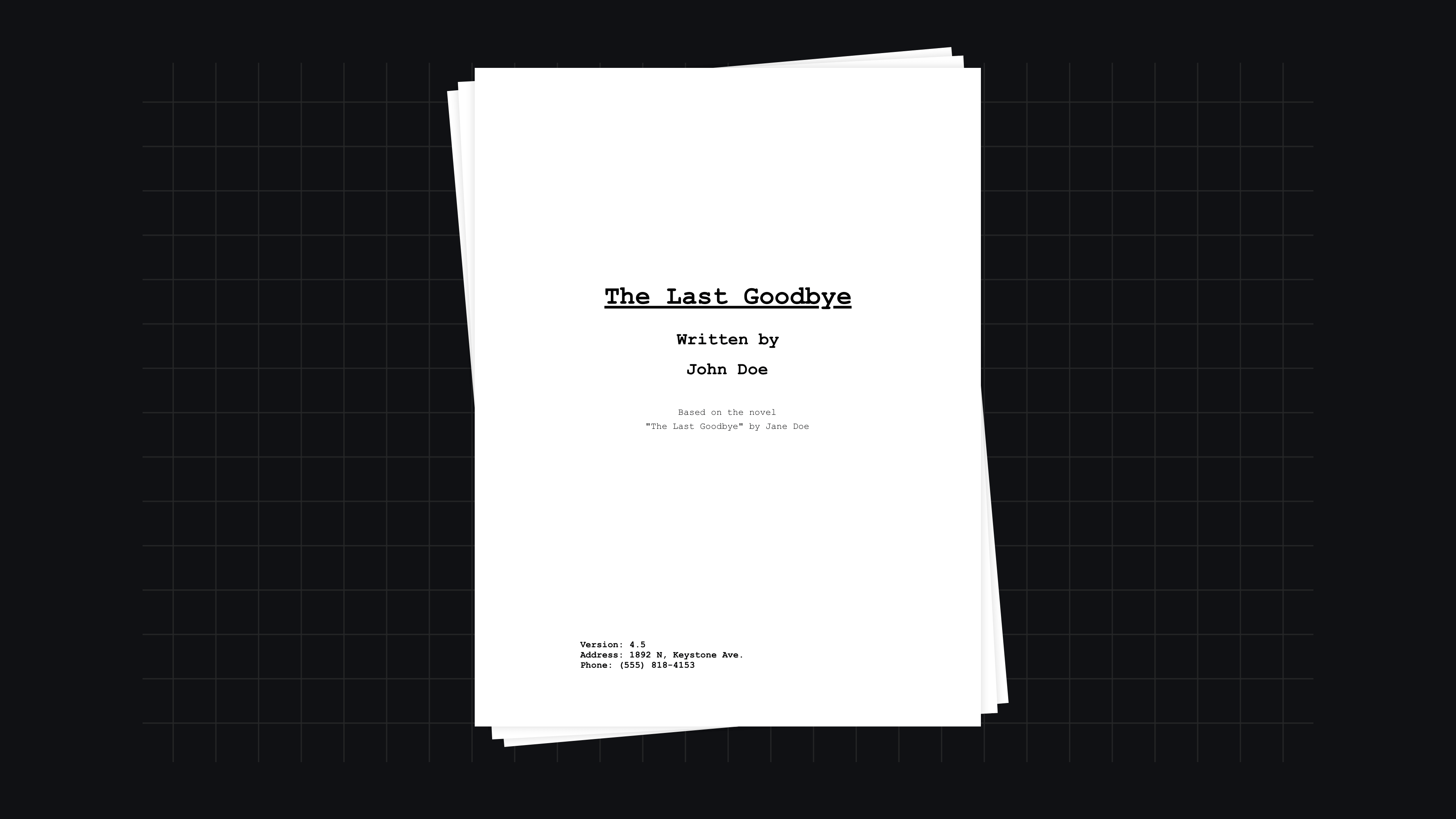
Screenplay Title Page Example
Additional Tips:
- Avoid unnecessary personal information – Unlike in the past, you don’t need to include your home address. A designated email for your screenwriting work is sufficient.
- Use standard formatting – The title page should be clean and simple. No images, no fancy fonts—just professional and easy to read.
- Keep it to one page – The title page should never exceed a single sheet.
A well-formatted title page sets the tone for your script. It’s a small but essential step that ensures your screenplay looks professional from the very first glance.
Related Posts
Sample Script
Other important screenwriting notes
Some nuanced screenwriting practices may seem correct but can confuse or hinder the physical production. Thorough pre production planning ensures a smoother transition from script to screen, saving time and resources.
Does this sound familiar? You understand script formatting, but after reading popular scripts, you’re more confused. Many screenwriters bend the rules, using format creatively to enhance pace and flow.
“Why follow strict rules when top writers don’t?”
Good question. Most scripts you read are early drafts or spec scripts, not production-ready versions. If you want your script to be production-friendly, it’s best to write with that in mind.
Up Next
Write Your Screenplay with StudioBinder
Now that you understand how to write a movie script, take the next step with StudioBinder’s screenwriting software. Whether you’re drafting your first screenplay or refining a professional project, our intuitive, cloud-based platform streamlines the writing process with industry-standard formatting, real-time collaboration, and seamless production integration. Explore the tools designed to elevate your screenwriting workflow and bring your vision to life.
